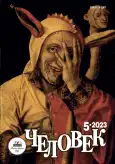Person Walking: Walkability as a Factor of Production of Urban Everyday Life
- 作者: Sharova V.L.1
-
隶属关系:
- RAS Institute of Philosophy
- 期: 卷 34, 编号 5 (2023)
- 页面: 53-69
- 栏目: Social practices
- URL: https://journals.rcsi.science/0236-2007/article/view/251301
- DOI: https://doi.org/10.31857/S023620070028502-9
- ID: 251301
全文:
详细
作者简介
Veronika Sharova
RAS Institute of Philosophy
ORCID iD: 0000-0002-7405-2992
12/1Goncharnaya Str., 109240 Moscow, Russian Federation
参考
- Беньямин В. Бодлер. М.: Ад Маргинем Пресс, 2015.
- Беньямин В. Париж, столица XIX столетия // Беньямин В. Озарения / пер. Н.М. Берновской, Ю.А. Данилова, С.А. Ромашко. М.: Мартис, 2000.
- Бичурин Н.Я. Описание Пекина / пер. с кит. СПб.: Тип. А. Смирдина. 1829.
- Бретон А., Супо Ф. Прозрачное зеркало // Вавилон: Вестник молодой литературы / пер. с фр. Д. Галь, М. Осокина и О. Ассовски. Вып. 2 (18). М.: АРГО-РИСК, 1993. С. 68‒71.
- Дебор Г.-Э. Психогеография. М.: Ад Маргинем Пресс, 2017.
- Джекобс Дж. Смерть и жизнь больших американских городов / пер. с англ. Л. Мотылева. М.: Новое издательство, 2011.
- Жертвы Стены. Berlin.de. Das offizielle Hauptstadtportal. URL: https://www.berlin.de/mauer/ru/istorija/shertwy-steny/#:~:text=С%201961%20по%201989%20год,из%20ГДР%3B%2030%20человек%20с (дата обращения: 27.06.2023).
- Заявление Общественного движения «Архнадзор». 25.10.2011. URL: https://www.archnadzor.ru/2011/10/25/kitajskij-zabor/#more-8603 (дата обращения: 15.06.2023).
- Оже М. От города воображаемого к городу-фикции // Художественный журнал. 1999. № 24. URL: www.guelman.ru/xz/362/xx24/x2402.htm (дата обращения: 20.06.2023)
- Оже М. Не-места. Введение в антропологию гипермодерна / пер. с франц. А.Ю. Коннова. М.: Новое литературное обозрение, 2017.
- Серто М. де. Изобретение повседневности. Т 1. Искусство делать / пер. с фр. Д. Калугина, Н. Мовниной. СПб.: Издательство Европейского университета в Санкт-Петербурге, 2013.
- Серто М. де. По городу пешком // Социологическое обозрение. 2008. Т. 7, № 2. С. 24–38.
- Терборн Й. Города власти. Город, нация, народ, глобальность / пер. с англ. А. Королева; под науч. ред. В. Данилова; М.: Изд. дом Высшей школы экономики, 2020.
- Трубина Е.Г. Город в теории: опыты осмысления пространства. М.: Новое литературное обозрение, 2010.
- Юрчак А. Это было навсегда, пока не кончилось. Последнее советское поколение / предисл. А. Беляева; пер. с англ. М.: Новое литературное обозрение, 2014.
- Assmann A. Erinnerung, Identität, Emotionen: Die Nation neu denken. Blatter.de. März 2020. URL: https://www.blaetter.de/ausgabe/2020/maerz/erinnerung-identitaet-emotionen-die-nation-neu-denken (date of access: 20.06.2023).
- Bartzokas-Tsiompras A., Photis Y.N. What matters when it comes to “Walk and the city”? Defining a weighted GIS-based walkability index. Transport Research Procedia. 2017. Vol. 24. P. 523–530.
- Baobeid A., Koç M., Al-Ghamdi S.G. Walkability and Its Relationships With Health, Sustainability, and Livability: Elements of Physical Environment and Evaluation Frameworks. Frontiers in Built Environment. 2021. Vol. 7. URL: https://www.frontiersin.org/articles/10.3389/fbuil.2021.721218 (date of access: 10.06.2023).
- Bekiaris E., Tsami M., Panou M. A “Greening Mobility” framework towards sustainability. Transport Research Procedia. 2017. Vol. 24. P. 131–136.
- Bischoff P. Surveillance camera statistics: which cities have the most CCTV cameras? URL: https://www.comparitech.com/vpn-privacy/the-worlds-most-surveilled-cities/ (date of access: 15.06.2023).
- Golan Y., Wilkinson N., Henderson J.M., Weverka A. Gendered walkability: Building a daytime walkability index for women. Journal of Transport and Land Use. 2019. N 12(1). URL: https://www.jtlu.org/index.php/jtlu/article/view/1472 (date of access: 12.06.2023).
- Kärrholm M., Johansson M., Lindelöw D., Ferreira I.A. Interseriality and Different Sorts of Walking: Suggestions for a Relational Approach to Urban Walking. Mobilities. 2017. N 12:1. P. 20‒35.
- Lefebvre H. Rhythmanalysis. Space, Time and Everyday Life. Transl. from French by: Elden S., Moore G. London, New York: Continuum, 2004.
- Liao B., van den Berg P.E.W., van Wesemael P.J.V, Arentze T.A. How Does Walkability Change Behavior? A Comparison between Different Age Groups in the Netherlands. Int J Environ Res Public Health. 2020. N 17(2): 540.
- Manzelat R.R., Emadi M.I., Kamali A.J. City Sustainability: the Influence of Walkability on Built Environments. Transportation Research Procedia. 2017. Vol. 24. P. 97–104.
- McEwan I. A Tale of Two Cities. The Guardian. 22.10.2005. URL: https://www.theguardian.com/books/2005/oct/22/featuresreviews.guardianreview31 (date of access: 29.06.2023).









